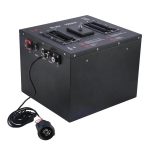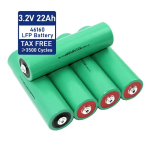Research and Development
Composed of more than 20 professional technicians and engineer to conduct research and development of batteries. We manufacture NiMH Battery, LiPO Battery and LiFePO4 batteries at the same time, we have advanced level technology of battery production.
If you have any design and idea on battery, please let us know, we will work out the solution and make it happen. All of Batteries are manufactured in our factory will be provided one stop solution, we are ALL IN ONE.
| We can provide customized batteries with discharge rates ranging from 3C to 150C depending on your needs. | |
| We are able to customize batteries that can work in different temperatures, from -40°to 80°. | |
| We are able to manufacture batteries that are irregularly shaped, such as round shape, curve shape and so on. |
Quality Control
All of finished products will be 100% checked before shipment, and all testing data will be given with shipment. We have more than 20 professional QC workers.Being professional does not mean never make mistakes, so all QC worker’s salary is based on the customers feedback of every order.So your feedback and suggestions are most welcome, that will help us to make improvement and gain customer’s confidence.
![]()
Quick Sample
Service.
![]()
Premium Material
Reserve.
![]()
Comprehensive
BatteryTest.
![]()
Strong Capabilities of R&D,
Design and Testing.
Service Precess

General Process
Customer Center
![]()
100% check the finished product
![]()
Regular characteristics in Specification sheet.
![]()
Special items based on customer’s requirements
![]()
All the data can be traced through the pack barcode.
![]()
Customers are welcome to co-work in OQCC.
FAQs
Below you will find the answers to the common questions.
| 1 - General |
| Q: Why does a battery discharge time be shorted? |
| A: Normally the battery internal resistance will be increased with more use, then the battery discharge performance will be degraded, and voltage drops more fast, so the discharge time be shorted. |
| Q: What is the difference between parallel and series circuits? |
| A: Parallel circuit is involved two or more batteries connected to extend the capacity. In this case, the positive terminals are connected together, and the negative terminals are connected together until the desired capacity reached. Series circuit connects two or more batteries together to increase the voltage. We connect the positive terminal to the negative one until reaching the voltage we need. For example, if we series circuit two batteries with 12V, that will be 24 voltage in total. |
| Q: What are the advantages of lithium batteries? |
| A: High Energy Density: Electronic equipment such as mobile phones needing to operate longer between charges while still consuming more power, there is always a need to batteries with a much higher energy density. In addition to this, there are many power applications from power tools to electric vehicles. The much higher power density offered by lithium ion batteries is a distinct advantage. Electric vehicles also need a battery technology that has a high energy density. Self-Discharge: Lithium ion cells is that their rate of self-discharge is much lower than that of other rechargeable cells such as Ni-Cad and NiMH forms. It is typically around 5% in the first 4 hours after being charged but then falls to around 1 or 2% per month. Low Maintenance: One major lithium ion battery advantage is that they do not require and maintenance to ensure their performance. Ni-Cad cells required a periodic discharge to ensure that they did not exhibit the memory effect. As this does not affect lithium ion cells, this process or other similar maintenance procedures are not required. No requirement for priming: Some rechargeable cells need to be primed when they receive their first charge. There is no requirement for this with lithium ion cells and batteries. Variety of types available: There are several types of lithium ion cell available. This advantage of lithium ion batteries can mean that the right technology can be used for the particular application needed. Some forms of lithium ion battery provide a high current density and are ideal for consumer mobile electronic equipment. Others are able to provide much higher current levels and are ideal for power tools and electric vehicles. |
| 2 - LiPO Battery |
| Q: What is the high C rate LiPO battery? |
| A: Normally if the battery C rate ≥5C, then this kind of battery be defined as high C rate LiPO battery. ALL IN ONE high discharge C rate LiPO battery can be discharged up to 60C continuously, and 200C pulse. What's more, such batteries can be fast charged via 5C. |
| Q: How does a LiPo battery work at high temperatures? |
| A: The high C-rate LIPO battery provides higher discharge rate of up to 60C, and better stability, controlled within 65°C to prevent overheating and damage; |
| Q: What does the C rate stand for in the battery industry? |
| A: The C rate is representative of the charge and discharge capability of the lithium-ion polymer battery. The C rate is divided into a discharge rate and a charge rate, and "C" is used to indicate the ratio of the charge and discharge current of the battery, that is the rate. For example, a 1200 mAh battery, 0.2 C means 240 mA (0.2 mA of the 1200 mAh battery), and 1 C means 1200 mA (1 times rate of the 1200 mAh battery). Normally high discharge rate batteries can be fast-charged. |
| 3 - Shaped Battery |
| Q: Can shaped batteries support fast charge? |
| A: Yes, we're using advanced stacking technology and it can support fast charge and discharge. |
| Q: Can shape batteries be used in a low-temperature environment or high-temperature environment? |
| A: Currently, our shape batteries can be used at temperature -50 ℃~50 ℃ or 20 ℃~80 ℃. If you need anything different from this range, please send us more details for evaluation. |
| Q: What are the applications of shaped batteries? |
| A: Wearable devices like Smart Watches, Smart Wristbands, Wireless Headphones, VR/AR headset; Medical Equipment, Various Consumer Electronics, Smart Cards, Heating Clothing, Tracking Devices, Smart Locks, GPS trackers, Smart Rings, IoT devices, portable consumer electronics and so on. |
| Q: What's the advantage of shape batteries comparing with other regular rectangle batteries? |
| A: The main advantage is to make full use of the internal space of devices and increase the running time. |
| Q: What is the average battery life? |
| A: Generally, consumer wearable device's working current is within 0.5C, in this case, the battery life could be 1000 cycles. After 1000 cycles, the capacity maintained over 80%. |
| Q: What shape can be made? |
A: Every shape is possible. The thickness between 0.4~8mm, width between 6~50mm Shaped battery has over 5,000 batteries in various chemistries, sizes, shapes, and capacities. The following types are references:
|
| Q: What certification does ALL IN ONE have? |
| A: ALL IN ONE has passed IS09001, ISO14001, TS16949, OHSAS18001 quality system certification, and our products can pass ROHS, CE, UL, UN38.3, MSDS and other certification. If you need any product certifications, please let us know and we can help to apply for the certification for you. |
| 4 - LiFePO4 |
| Q: Does the LiFePO4 battery have a memory effect? |
| A: LiFePO4 batteries do not have memory effect. That means deep-discharge cycles are not required. In fact, it's better for the battery via shallow discharge and charge cycles. |
| Q: How many times does the promised cycle of ALL IN ONE's LiFePO4 battery reach? |
| A: Around 1500 times or three years of use, whichever comes first. |
| Q: Can ship LiFePO4 batteries to the United States or other regions? |
| A: Yes, but if you need to ship the battery internationally, you need to get the relevant certification. For example, the battery transported by air to some regions (e.g. Unite State) must be UN38.3 certified, pass various safety tests to ensure the safe transportation of batteries. |
| Q: Is the lithium iron phosphate battery dangerous? |
| A: LiFePO4 batteries are environmentally safe and structurally stable. They own excellent high temperature performance. The chemistry of the battery saves it from thermal runaway, and hence it is considered to be safe for home use. |
| 5 - Low Temperature Battery |
| Q: What is the minimum charging temperature for low temperature batteries? |
| A: Can be charged at -20℃ (Minimum); |
| Q: What is the minimum discharge temperature? |
| A: The operating temperature range is between -50℃ to 55℃;The discharging capacity of 0.5C at -40℃ is over 60% of initial capacity; 0.3C at -35℃ is over 70% of initial capacity; |
| Q: What is the chemistry of the low temperature battery? |
| A: ALL IN ONE low temperature LiFePO4 battery takes new technology from long-term development, we add special functional materials into the electrolyte, the excellent technology can ensure the great low temperature discharge performance. |
| Q: Can customized the dimension? |
| A: ALL IN ONE offers customization battery solution with a small order. If you need to know more, please contact our supporting team. |
| 6 - Others |
| Q: What can I be served in addition to the products? |
| A: One-Stop Battery Service: The one-stop service includes: battery design, R&D, technical, logistics and after-sales support. Let you can focus your precious time on more valuable work. You can view the service page(link) to get more information. Customization Service: ALL IN ONE's advanced battery technology can fulfil various requirements, either voltage or size, voltage, or capacity. Our techniques are not bound on parameters we displayed. Please feel free to consult our experts to design a unique battery solution |


